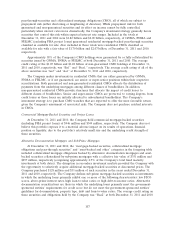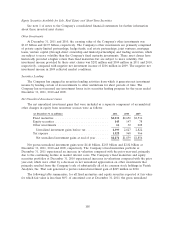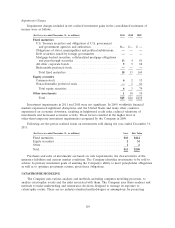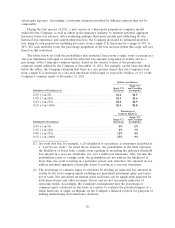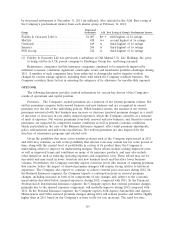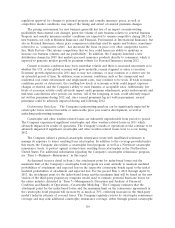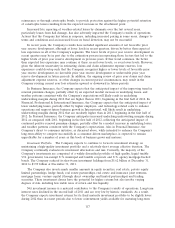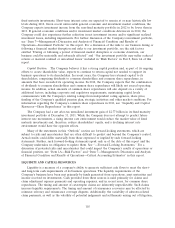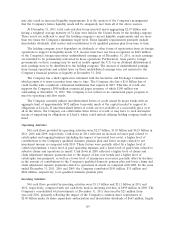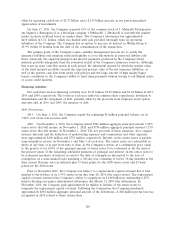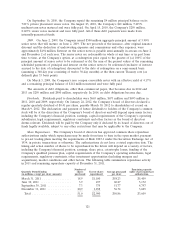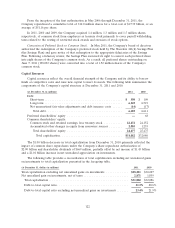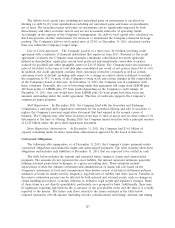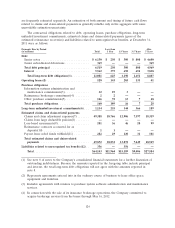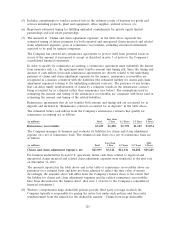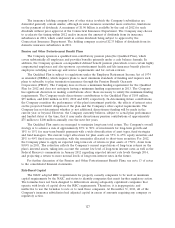Travelers 2011 Annual Report Download - page 129
Download and view the complete annual report
Please find page 129 of the 2011 Travelers annual report below. You can navigate through the pages in the report by either clicking on the pages listed below, or by using the keyword search tool below to find specific information within the annual report.reinsurance or through catastrophe bonds, to provide protection against the higher potential retention
of catastrophe losses resulting from the expected increase in the attachment point.
Increased late reporting of weather-related losses by claimants over the last several years,
particularly losses from hail damage, has also adversely impacted the Company’s results of operations.
Actions that the Company has taken in response, including increased pricing in some areas, changes to
terms and conditions and an increased focus on fraud detection, may not be successful.
In recent years, the Company’s results have included significant amounts of net favorable prior
year reserve development, although at lower levels in recent quarters, driven by better than expected
loss experience in all of the Company’s segments. The lower levels of prior year reserve development in
recent quarters may be in part due to the estimation process incorporating those factors that led to the
higher levels of prior year reserve development in previous years. If that trend continues, the better
than expected loss experience may continue at these recent lower levels, or even lower levels. However,
given the inherent uncertainty in estimating claims and claim adjustment expense reserves, loss
experience could develop such that the Company recognizes higher or lower levels of favorable prior
year reserve development, no favorable prior year reserve development or unfavorable prior year
reserve development in future periods. In addition, the ongoing review of prior year claims and claim
adjustment expense reserves, or other changes in current period circumstances, may result in the
Company revising current year loss estimates upward or downward in future periods.
In Business Insurance, the Company expects that the anticipated impact of the improving trend in
renewal premium changes, partially offset by an expected modest increase in underlying losses, and
weather patterns consistent with the Company’s expectations will likely result in underlying
underwriting margins during 2012 that are higher than in 2011, beginning in the first half of 2012. In
Financial, Professional & International Insurance, the Company expects that the anticipated impact of
lower underlying losses, partially offset by higher employee- and technology-related costs to enhance
operations and support future business growth in International, will likely result in underlying
underwriting margins during 2012 that are modestly higher than in 2011, beginning in the first half of
2012. In Personal Insurance, the Company anticipates increased underlying underwriting margins during
2012 as compared with 2011, beginning in the first half of 2012, reflecting the anticipated impact of
continued positive renewal premium changes, partially offset by a modest increase in underlying losses,
and weather patterns consistent with the Company’s expectations. Also in Personal Insurance, the
Company’s direct to consumer initiative, as discussed above, while intended to enhance the Company’s
long-term ability to compete successfully in a consumer-driven marketplace, is expected to remain
unprofitable for a number of years as this book of business grows and matures.
Investment Portfolio. The Company expects to continue to focus its investment strategy on
maintaining a high-quality investment portfolio and a relatively short average effective duration. The
Company continually evaluates its investment alternatives and mix. Currently, the majority of the
Company’s investments are comprised of a widely diversified portfolio of high quality, liquid taxable
U.S. government, tax-exempt U.S. municipal and taxable corporate and U.S. agency mortgage-backed
bonds. The Company reduced its short-term investment holdings from $5.62 billion at December 31,
2010 to $3.59 billion at December 31, 2011.
The Company also invests much smaller amounts in equity securities, real estate, private equity
limited partnerships, hedge funds, real estate partnerships, real estate and insurance joint ventures,
mortgage loans, venture capital (through direct ownership and limited partnerships) and trading
securities. These investment classes have the potential for higher returns but also involve varying
degrees of risk, including less stable rates of return and less liquidity.
Net investment income is a material contributor to the Company’s results of operations. Long-term
interest rates declined in the second half of 2011 and are very low by historic standards. As a result,
the Company expects investment returns for its fixed maturity investment portfolio to be slightly lower
during 2012 than in recent periods due to lower reinvestment yields available for maturing long-term
117


